Tác động của quản trị công ty đến hiệu quả doanh nghiệp: Nghiên cứu thực nghiệm từ thị trường chứng khoán Việt Nam
Nghiên cứu này được thực hiện nhằm mục đích tìm hiểu tác động của cơ chế quản trị công
ty đến hiệu quả doanh nghiệp đối với các công ty đại chúng tại Việt Nam. Bằng việc sử dụng dữ
liệu về cơ chế quản trị công ty của 263 công ty niêm yết tại Việt Nam trong giai đoạn từ 2011 đến
2017, Chúng tôi xây dựng chỉ số phụ về quản trị công ty mô tả ở các khía cạnh khác nhau của
quản trị công ty như: Quy mô Hội đồng quản trị (Board Size), thành viên HĐQT không tham gia
điều hành (NEDs), cấu trúc sở hữu vốn và bồi hoàn ban điều hành. Bên cạnh đó, hiệu quả doanh
nghiệp được đo lường bằng lợi nhuận trên vốn chủ sở hữu (ROE). Chúng tôi sử dụng phương
pháp hồi quy bình phương nhỏ nhất thông thường (OLS), hiệu ứng tác động cố định (FEM), hiệu
ứng tác động ngẫu nhiên (REM) để phân tích các tác động của quản trị công ty lên hiệu quả
doanh nghiệp. Dựa trên một mẫu các doanh nghiệp niêm yết của Việt Nam và sử dụng hồi quy
dữ liệu bảng, kết quả cho thấy sở hữu CEO, sở hữu Chủ tịch HĐQT và quyền sở hữu của Chính
phủ có tác động tiêu cực đáng kể đến tỷ suất sinh lời trên vốn chủ sở hữu. Ngoài ra, kết quả cũng
chỉ ra rằng Tỷ suất sinh lời đạt mức cao hơn ở những công ty có mức chi trả bồi hoàn cho ban
điều hành cao.
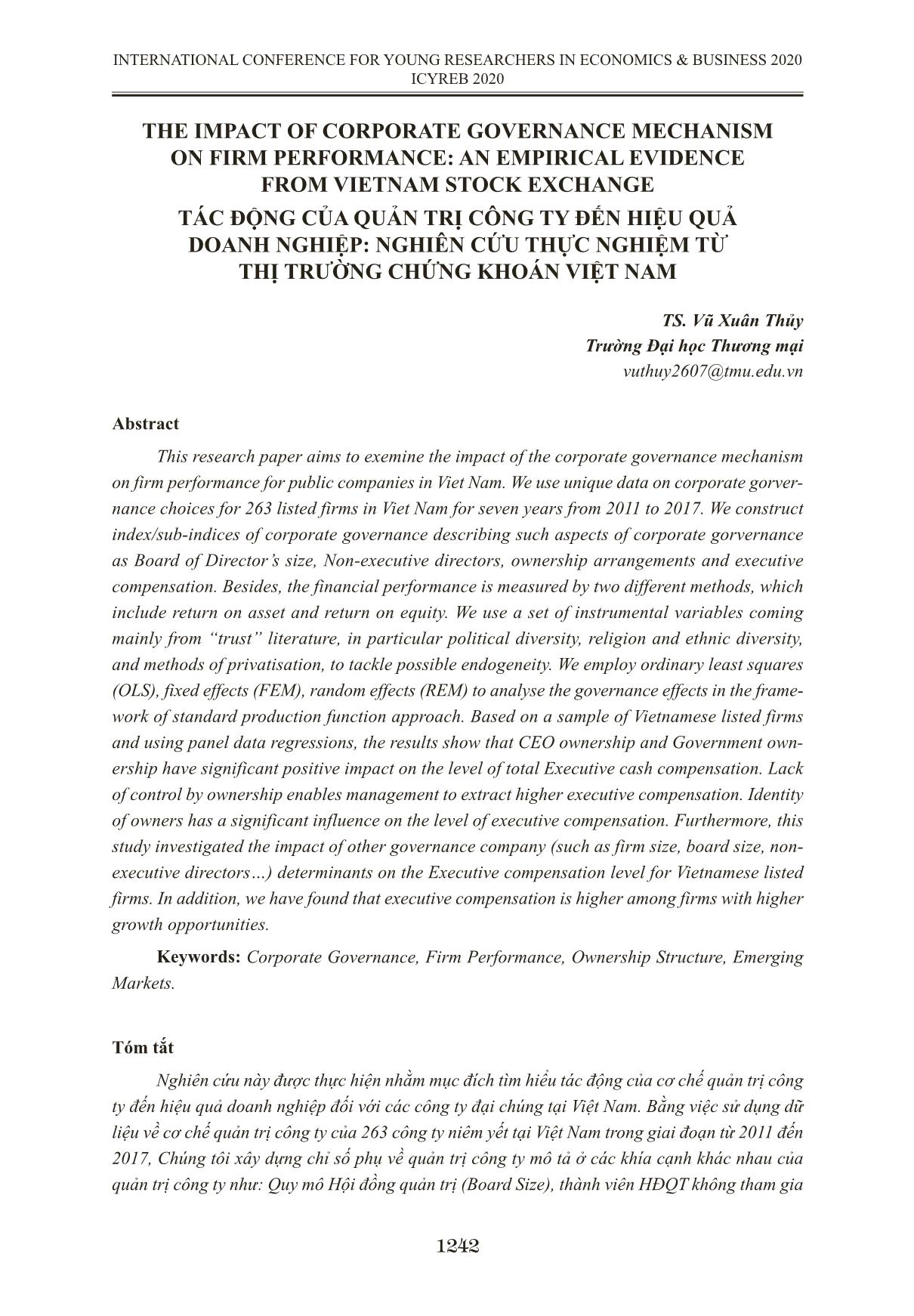
Trang 1
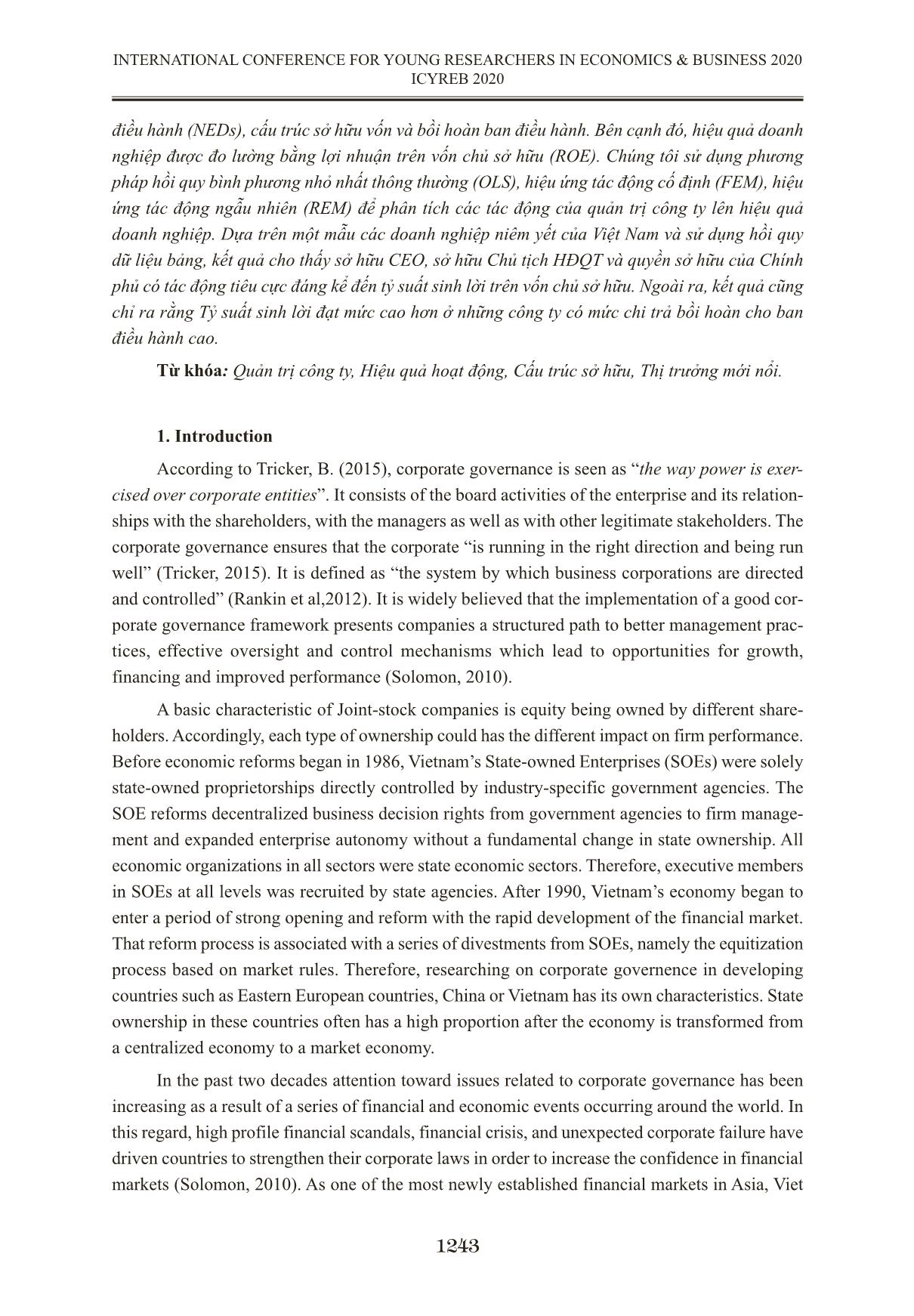
Trang 2
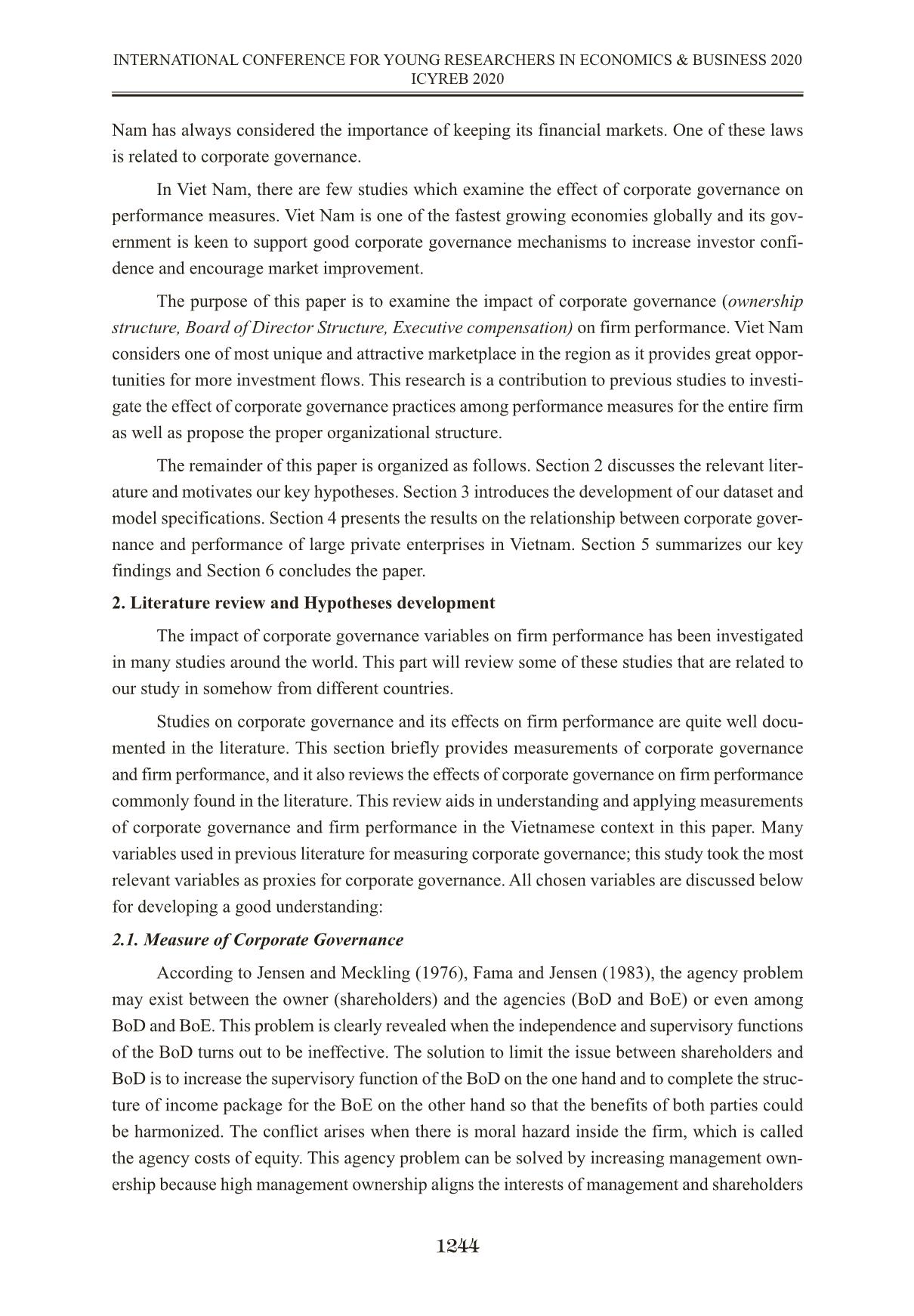
Trang 3
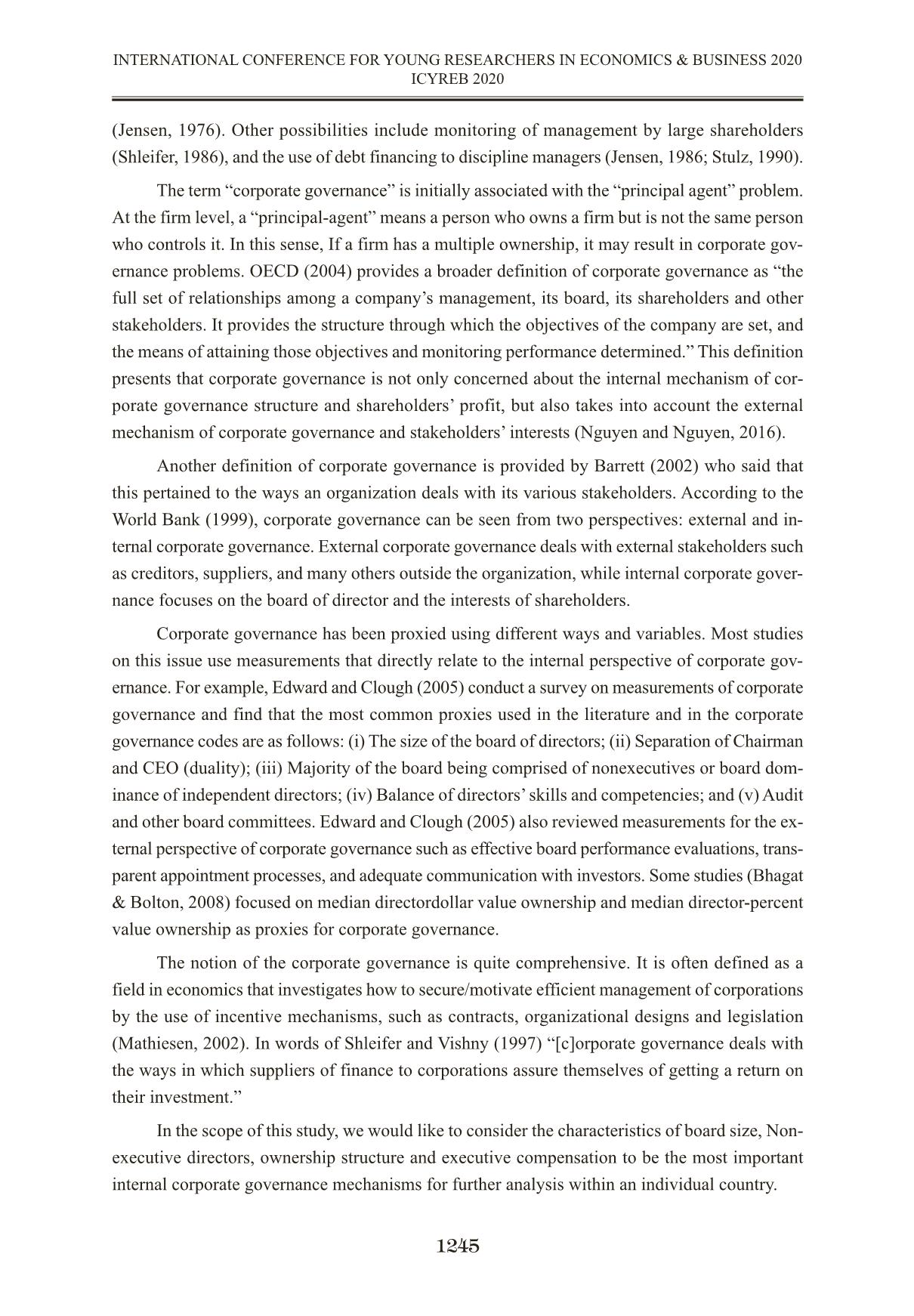
Trang 4
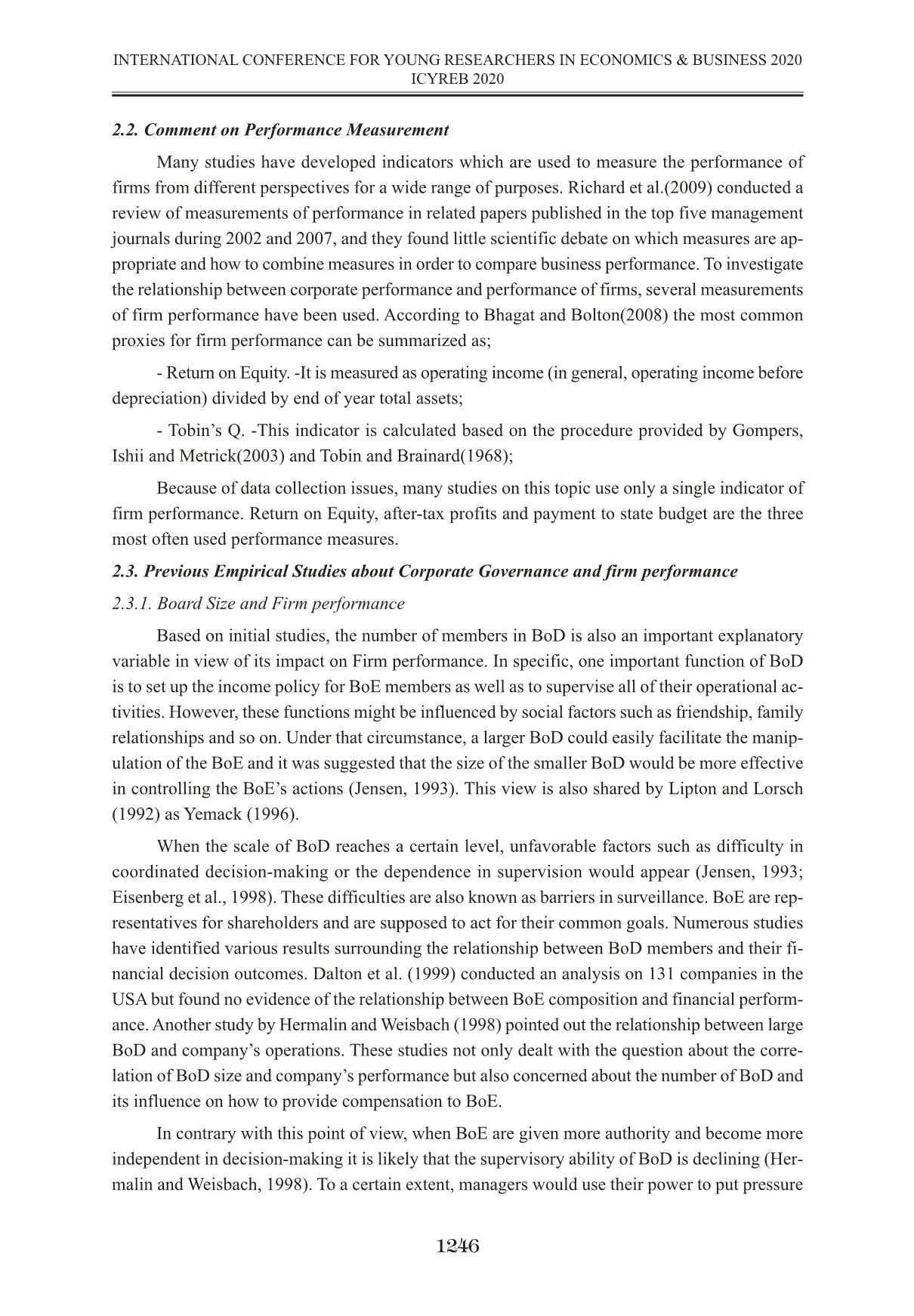
Trang 5
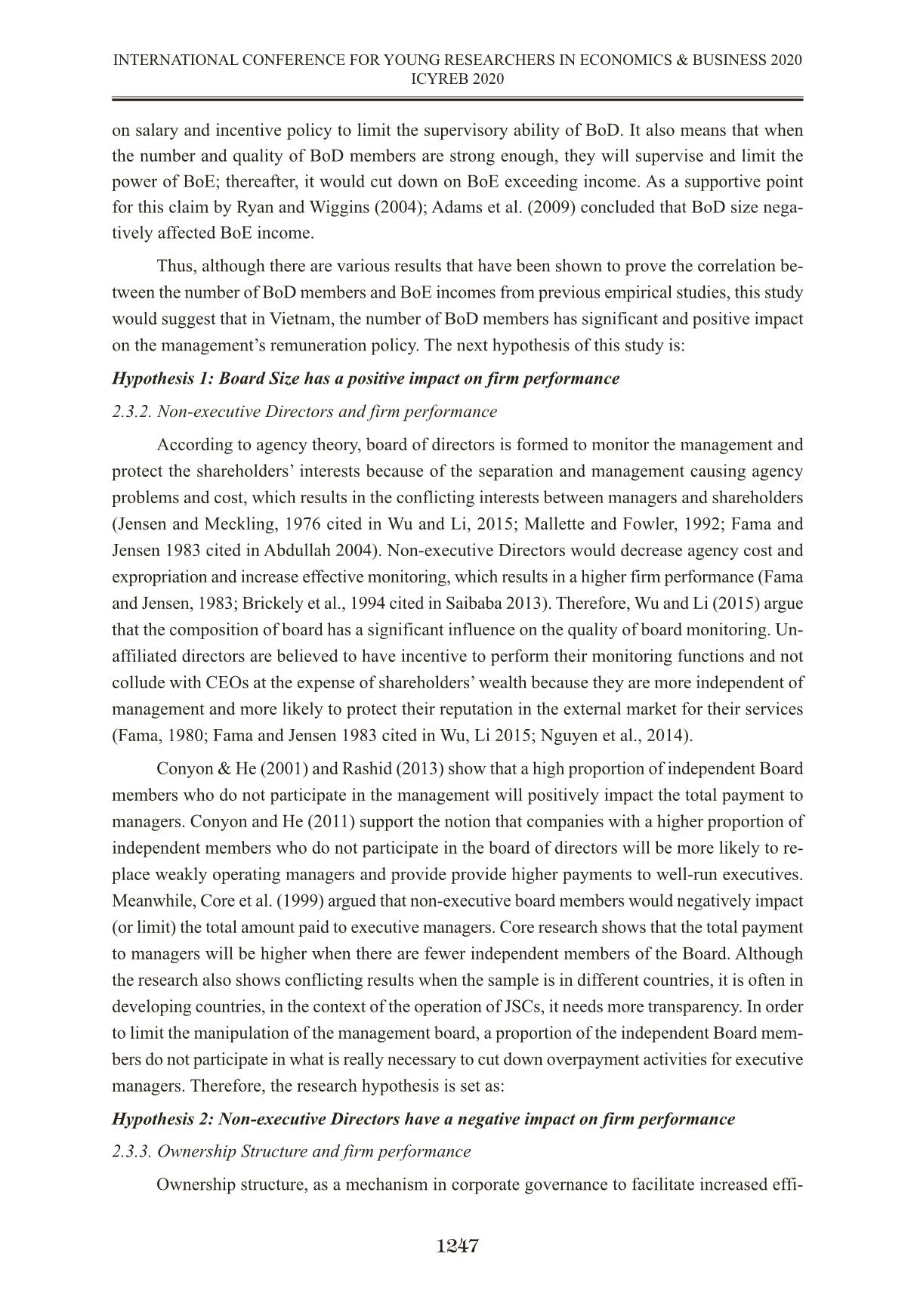
Trang 6
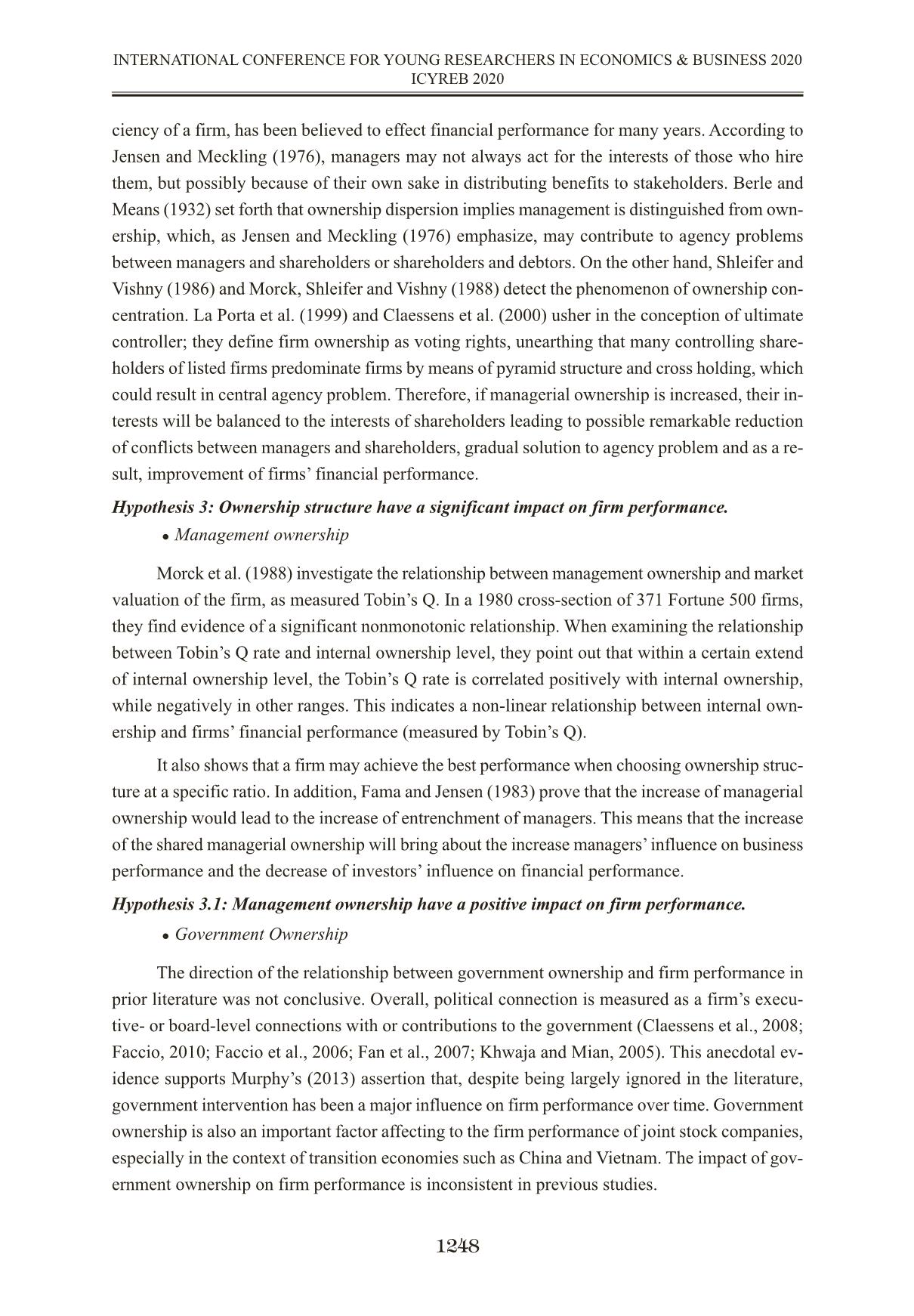
Trang 7
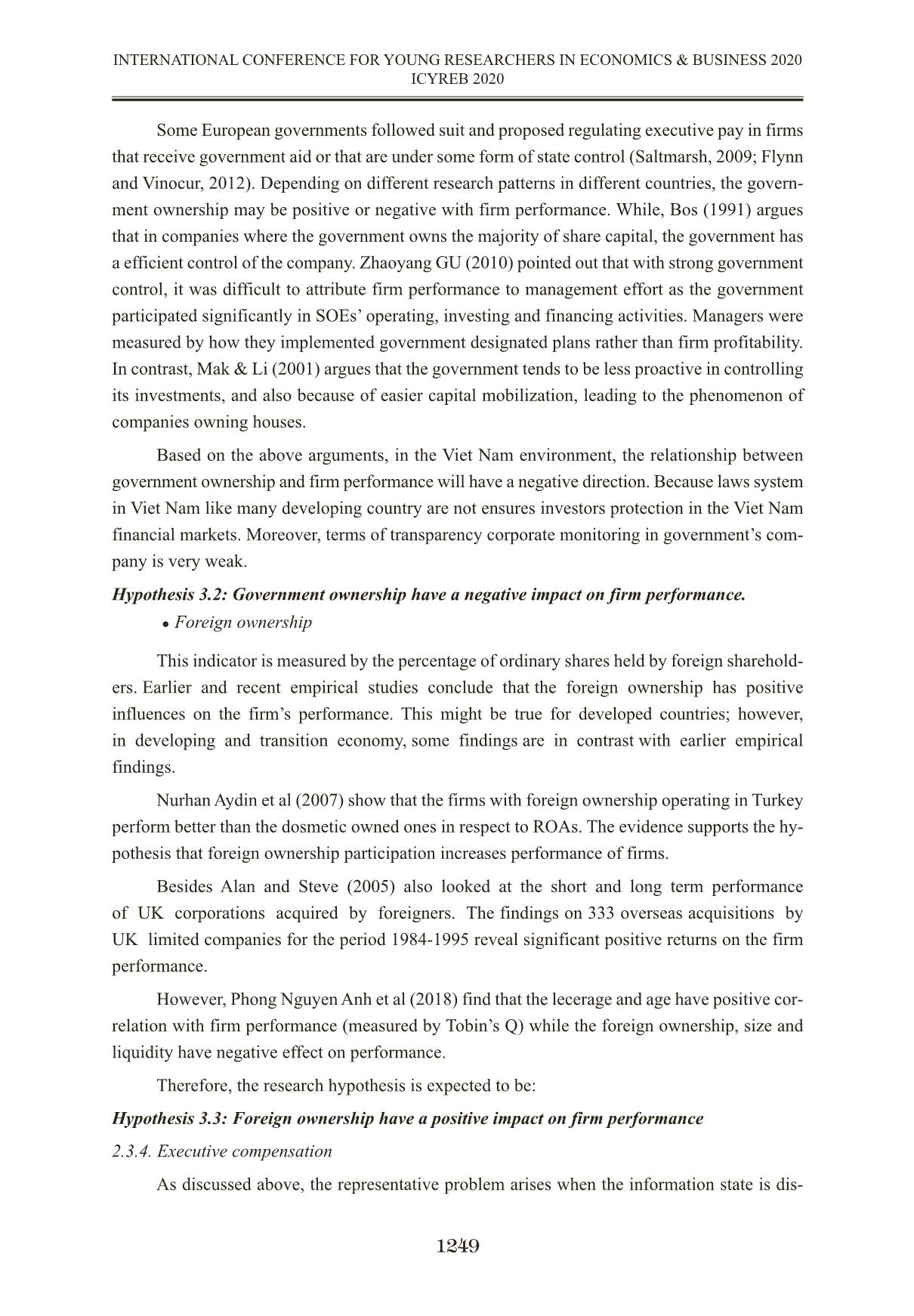
Trang 8
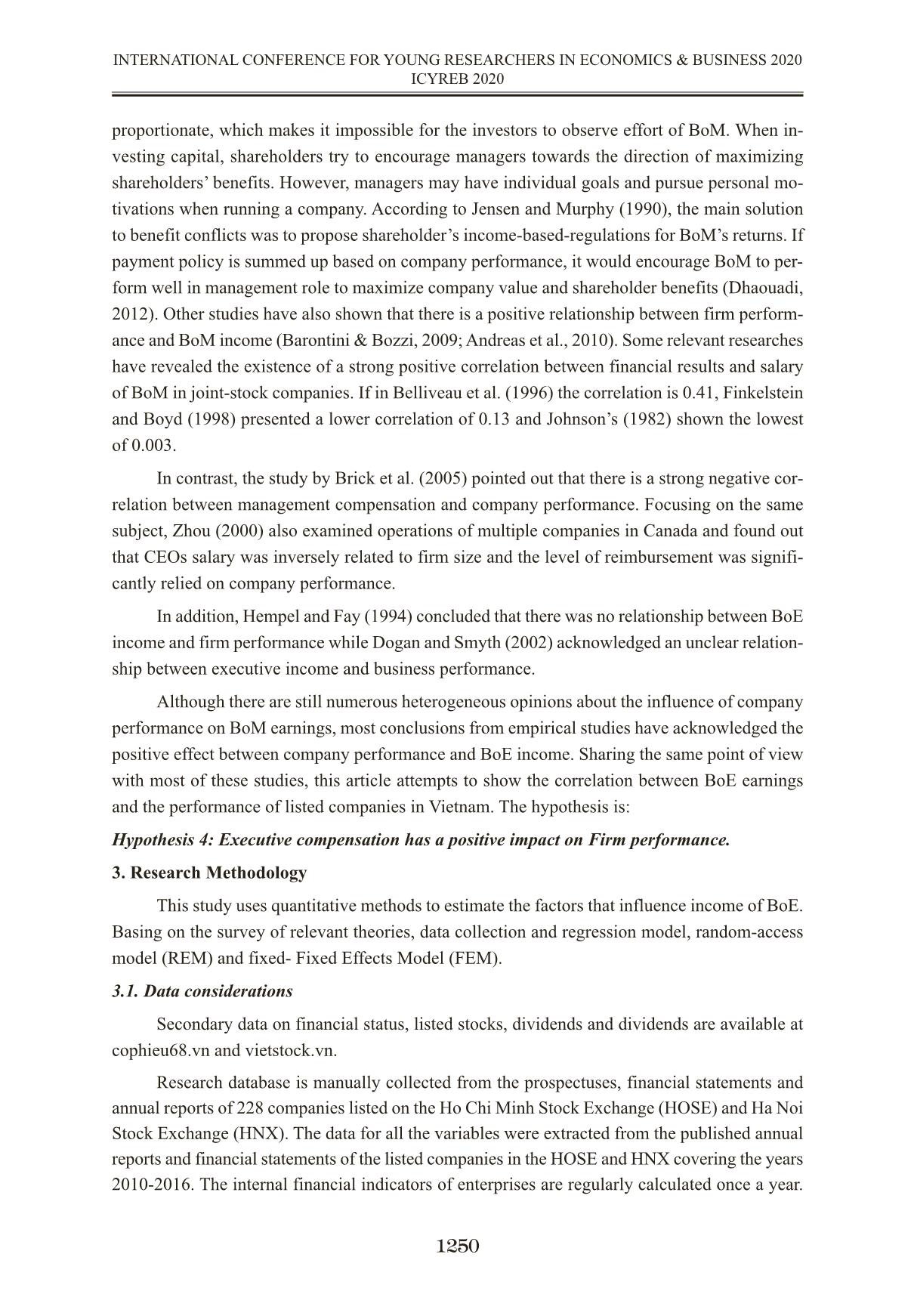
Trang 9
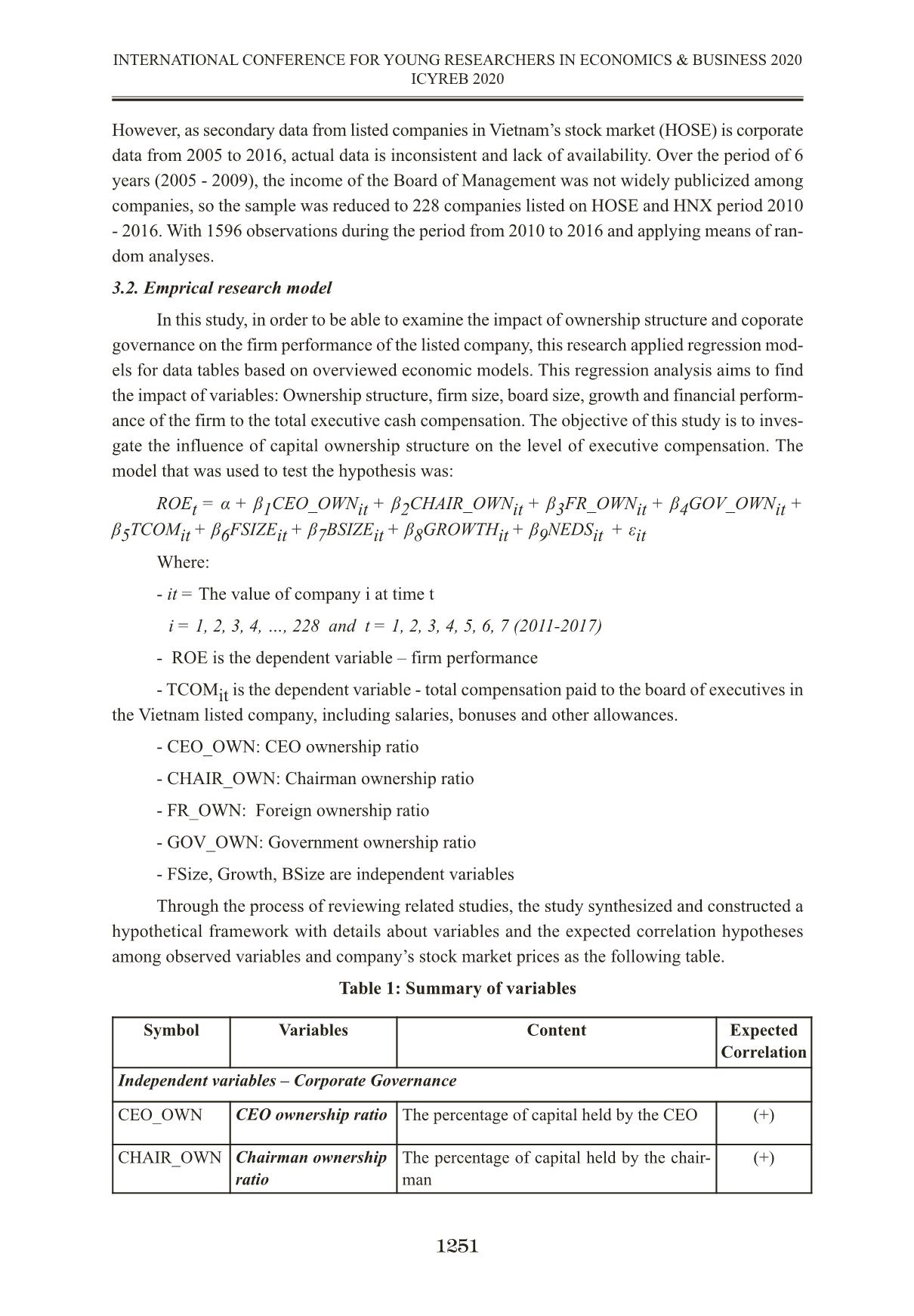
Trang 10
Tải về để xem bản đầy đủ
Tóm tắt nội dung tài liệu: Tác động của quản trị công ty đến hiệu quả doanh nghiệp: Nghiên cứu thực nghiệm từ thị trường chứng khoán Việt Nam
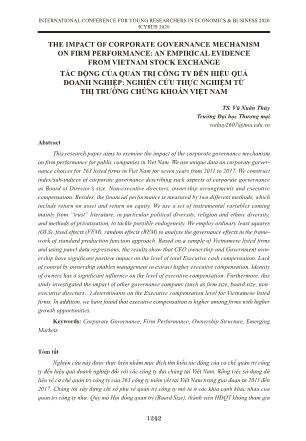
THE IMPACT OF CORPORATE GOVERNANCE MECHANISM ON FIRM PERFORMANCE: AN EMPIRICAL EVIDENCE FROM VIETNAM STOCK EXCHANGE TÁC ĐỘNG CỦA QUẢN TRỊ CÔNG TY ĐẾN HIỆU QUẢ DOANH NGHIỆP: NGHIÊN CỨU THỰC NGHIỆM TỪ THỊ TRƯỜNG CHỨNG KHOÁN VIỆT NAM TS. Vũ Xuân Thủy Trường Đại học Thương mại vuthuy2607@tmu.edu.vn Abstract This research paper aims to exemine the impact of the corporate governance mechanism on firm performance for public companies in Viet Nam. We use unique data on corporate gorver- nance choices for 263 listed firms in Viet Nam for seven years from 2011 to 2017. We construct index/sub-indices of corporate governance describing such aspects of corporate gorvernance as Board of Director’s size, Non-executive directors, ownership arrangements and executive compensation. Besides, the financial performance is measured by two different methods, which include return on asset and return on equity. We use a set of instrumental variables coming mainly from “trust” literature, in particular political diversity, religion and ethnic diversity, and methods of privatisation, to tackle possible endogeneity. We employ ordinary least squares (OLS), fixed effects (FEM), random effects (REM) to analyse the governance effects in the frame- work of standard production function approach. Based on a sample of Vietnamese listed firms and using panel data regressions, the results show that CEO ownership and Government own- ership have significant positive impact on the level of total Executive cash compensation. Lack of control by ownership enables management to extract higher executive compensation. Identity of owners has a significant influence on the level of executive compensation. Furthermore, this study investigated the impact of other governance company (such as firm size, board size, non- executive directors) determinants on the Executive compensation level for Vietnamese listed firms. In addition, we have found that executive compensation is higher among firms with higher growth opportunities. Keywords: Corporate Governance, Firm Performance, Ownership Structure, Emerging Markets. Tóm tắt Nghiên cứu này được thực hiện nhằm mục đích tìm hiểu tác động của cơ chế quản trị công ty đến hiệu quả doanh nghiệp đối với các công ty đại chúng tại Việt Nam. Bằng việc sử dụng dữ liệu về cơ chế quản trị công ty của 263 công ty niêm yết tại Việt Nam trong giai đoạn từ 2011 đến 2017, Chúng tôi xây dựng chỉ số phụ về quản trị công ty mô tả ở các khía cạnh khác nhau của quản trị công ty như: Quy mô Hội đồng quản trị (Board Size), thành viên HĐQT không tham gia 1242 INTERNATIONAL CONFERENCE FOR YOUNG RESEARCHERS IN ECONOMICS & BUSINESS 2020 ICYREB 2020 điều hành (NEDs), cấu trúc sở hữu vốn và bồi hoàn ban điều hành. Bên cạnh đó, hiệu quả doanh nghiệp được đo lường bằng lợi nhuận trên vốn chủ sở hữu (ROE). Chúng tôi sử dụng phương pháp hồi quy bình phương nhỏ nhất thông thường (OLS), hiệu ứng tác động cố định (FEM), hiệu ứng tác động ngẫu nhiên (REM) để phân tích các tác động của quản trị công ty lên hiệu quả doanh nghiệp. Dựa trên một mẫu các doanh nghiệp niêm yết của Việt Nam và sử dụng hồi quy dữ liệu bảng, kết quả cho thấy sở hữu CEO, sở hữu Chủ tịch HĐQT và quyền sở hữu của Chính phủ có tác động tiêu cực đáng kể đến tỷ suất sinh lời trên vốn chủ sở hữu. Ngoài ra, kết quả cũng chỉ ra rằng Tỷ suất sinh lời đạt mức cao hơn ở những công ty có mức chi trả bồi hoàn cho ban điều hành cao. Từ khóa: Quản trị công ty, Hiệu quả hoạt động, Cấu trúc sở hữu, Thị trưởng mới nổi. 1. Introduction According to Tricker, B. (2015), corporate governance is seen as “the way power is exer- cised over corporate entities”. It consists of the board activities of the enterprise and its relation- ships with the shareholders, with the managers as well as with other legitimate stakeholders. The corporate governance ensures that the corporate “is running in the right direction and being run well” (Tricker, 2015). It is defined as “the system by which business corporations are directed and controlled” (Rankin et al,2012). It is widely believed that the implementation of a good cor- porate governance framework presents companies a structured path to better management prac- tices, effective oversight and control mechanisms which lead to opportunities for growth, financing and improved performance (Solomon, 2010). A basic characteristic of Joint-stock companies is equity being owned by different share- holders. Accordingly, each type of ownership could has the different impact on firm performance. Before economic reforms began in 1986, Vietnam’s State-owned Enterprises (SOEs) were solely state-owned proprietorships directly controlled by industry-specific government agencies. The SOE reforms decentralized business decision rights from government agencies to firm manage- ment and expanded enterprise autonomy without a fundamental change in state ownership. All economic organizations in all sectors were state ... ob. Cross-section random 50.494457 9 0.0000 Dependent Variable: ROE Method: Panel Least Squares Date: 11/11/20 Time: 10:33 Sample: 2010 2016 Periods included: 7 Cross-sections included: 228 Total panel (balanced) observations: 1596 Variable Coefficient Std. Error t-Statistic Prob. TCOM 0.059310 0.018420 3.219872 0.0013 FSIZE 0.065313 0.023350 2.797167 0.0052 BSIZE -0.005256 0.013840 -0.379795 0.7042 NEDS 0.000286 0.010997 0.025966 0.9793 CEO_OWN -0.002066 0.000851 -2.428171 0.0153 Source: researcher’s caculation from research data Notes: *, **, *** denote significance at the 1%, 5% and 10% levels, respectively Thus, the regression model has the following results: ROEt = -2.87378 – 0.002066CEO_OWNit - 0.001542GOV_OWNit +0.00198CHAIR_OWNit + 0.05931TCOMit + 0.065313FSIZEit 5. Results Discussion Before discussing the results, the study will summarize the expectations for the relationship between the independent variable and the dependent variable and the results of the study after estimating the regression model of the factors influencing the firm performanc. The summary re- sults are presented in Table 7 below: Table 7: Result regression 1256 INTERNATIONAL CONFERENCE FOR YOUNG RESEARCHERS IN ECONOMICS & BUSINESS 2020 ICYREB 2020 CHAIR_OWN 0.001980 0.000931 2.127028 0.0336 FR_OWN 0.001265 0.001104 1.145775 0.2521 GOV_OWN -0.001542 0.000906 -1.701479 0.0891 GROWTH_MV_BV -0.006475 0.008975 -0.721528 0.4707 C -2.873780 0.686764 -4.184521 0.0000 Effects Specification Cross-section fixed (dummy variables) Period fixed (dummy variables) R-squared 0.274989 Mean dependent var S.D. dependent var Akaike info criterion Schwarz criterion Hannan-Quinn criter. Durbin-Watson stat 0.110701 Adjusted R-squared 0.145313 0.267138 S.E. of regression 0.246967 0.180211 Sum squared resid 82.52310 0.998624 Log likelihood 99.19174 0.484153 F-statistic 2.120576 2.349512 Prob(F-statistic) 0.000000 Observative variable Expection Regression result Note TCOM + + Match with expectation FSIZE + + Match with expectation BSIZE + 0 No meaning Source: researcher’s caculation from research data The main purpose of this study is to examine the impact of governance mechanism on firm performance in joint-stock companies listed on centralised securities market in Vietnam. Based on the above results, after running the regression models with 4 explanatory vari- ables, there are 5 factors of governance mechanism that impact on the firm performance in joint- stock companies listed on Ho Chi Minh Stock Exchange (HOSE) and Hanoi (HNX); in which, there are 4 statistically significant variables (p-value <5%), including: Executive compensation (TCOM), Firm size (FSIZE), Chair ownership and CEO ownership (CEO_OWN) and 1 variable are statistically significant (with p-value <10%) is government ownership ratio (GOV_OWN). The level of explanation of the three groups’ factors is recognized at approximately 25% and this rate is considered to be not remarkable. However, it is suggested to be understandable as apart from those mentioned above factors, there are numerous not-yet-to-be-mentioned as well other qualitative factors that could not be quantified. The results of the study also showed a different impact on the capital ownership ratio of different components to the firm performance of listed companies in Vietnam. - CEO and Chair ownership: The research results show that CEO and Chair ownership has a negative and significant effect on firm performance with p-value <0.05. That means, the executive board with a high percentage of ownership often has a deep right to decrease firm per- formance. It is suggested that the executive board holds a large percentage of shares, the salary and bonus are also higher, and so incentive for increase firm performance. - Government ownership: The results of the regression model show that the Beta coefficient represents a negative correlation between Government ownership and firm performance (statis- tically significant with p-value<0.1). This means, companies with higher levels of ownership by the state will reduce firm performance. Because the key executive managers of these companies who usually represent state ownership tend to build prudent business plans, which leads to two issues: (i) The level of bonus payment to managers will tend to be higher than the actual per- formance of the company; ii) The board of executives could be lack of motivation. - Foreign ownership: The research results show that the impact of foreign ownership factors on firm performance of listed companies is not statistically significant, but the correlation coef- ficient between these two variables is still positive. 1257 INTERNATIONAL CONFERENCE FOR YOUNG RESEARCHERS IN ECONOMICS & BUSINESS 2020 ICYREB 2020 NEDs - 0 No meaning CEO__OWN + - Not Match with expectation CHAIR__OWN + - Not Match with expectation FR__OWN - 0 No meaning GOV__OWN - - Match with expectation GROWTH + 0 No meaning - Board Size: The research results show that the impact of foreign ownership factors on firm performance of listed companies is not statistically significant, but the correlation coefficient between these two variables is still positive. - Firm Size: has positive and statistically significant correlation (+) with firm performance. The study outcomes clarify a positive and significant effect of firm size on firm performance, which align with the initial expectation. The larger companies, the higher firm performance. This conclusion is consistent with Baker et al. (1988) and Darmadi (2011) arguments that large com- panies have more financial resources to hire senior staff for management role and pay higher re- imbursement. In addition, large companies have complex business models and high level of diversification so they pay higher salary and bonus to BoE to handle complex tasks that require advanced skills. Moreover, the process of analysing data in research tables revealed that when using cross section weights to examine individual conditions of each company, if managers help increase company size in financial market it seams like there might be an increase in their income. However, this tendency is not quite clear as it did not happen with all research targets. - Executive compensation (TCOM) According to Kubo (2001), shareholders do not have enough information and necessary insight to monitor BoE. Therefore, in order to increase the ef- fectiveness of monitoring activities; shareholders, which are represented by BoD and Board of Supervisors should supervise BoE activities and at the same time associate company benefits (business performance) and BoM benefits (income paid). In addition, the “efficiency-based” pay- ment model is the focal point of representative theory and thereby forming a correlative relation- ship between firm performance and income level which helps adjust the benefits between shareholders and BoE (Jensen, 1993). The research results were supported by representative the- ory and studies by Barontini and Bozzi (2009), Darmadi (2011). 6. Conclusion There have been many research conducted concerning firm performance in developed mar- kets, however, not enough attention has been paid to emerging market like Viet Nam. This paper is one of the pioneer studies on the relationship between corporate governance and performance of firms in Vietnam. This research has provided new evidence on the relationship between cor- porate governance and performance of large private enterprises in Vietnam. Using a database on all listed companies in the Vietnamese stock market, this study has evaluated the extent and direction of impact of gorvernance on firm performance in the period of 2010 - 2016. Furthermore, this study also examined the impact of governance factors and executive compensation on firm performance in Vietnam. The research result shows that ex- ecutive compensation tends to increase in large-scale companies and achieve higher financial performance. Economic reforms in Vietnam are still an ongoing process. Further decentralizing govern- ment control appears to be the direction that is likely to occur. Our results suggest that reducing the direct involvement in firms’ business activities while allowing the government to retain the ultimate control of SOEs is likely to lead to better firm performance, especially when substituted with incentive pay schemes. Executive compensation in SOEs has received more stringent public 1258 INTERNATIONAL CONFERENCE FOR YOUNG RESEARCHERS IN ECONOMICS & BUSINESS 2020 ICYREB 2020 scrutiny in recent years. Much of the controversy focuses on the rising level of compensation and a lack of strong tie to performance. Our study suggests a possible tendency of over-compen- sation when government ownership is higher. What appears to be important is to strengthen the tie between pay and performance. When setting compensation policies, the government should consider its involvement in the firms’ business activities rather than simply issuing a “compen- sation limit” for all firms. REFERENCES 1. Adams, J. (1996), “Principals and agents, colonialists and company men: The decay of colonial control in the Dutch East Indies”, American Sociological Review, 61(1), 12–28. 2. Agrawal, A., & Knoeber, C. R. (1996), “Firm performance and mechanisms to control agency problems between managers and shareholders”, Journal of Financial and Quantitative Analysis, 31(3), 377–397. 3. Ahmed, A. (2009), “Managerial ownership concentration and agency conflict using logistic regression approach: Evidence from Bursa Malaysia”, Journal of Management Research, 1(1), 1–10. 4. Andreas, J. M., Rapp, M. S. and Wolff, M. (2010), “Determinants of director compen- sation in two-tier systems: evidence from German panel data”. CEFS working paper series, 06. 5. Berkema, H.G. and Gomez-Mejia, L.R., 1998, “Managerial compensation and firm per- formance: A general research framework”, Academy of Management Journal, Vol. 41, No.2, 135-145. 6. Bebchuk, L. A., Fried, J. M. (2003), “Executive compensation as an agency problem”, Journal of Economic Perspectives. 17, 71-92. 7. Bhagat, S. and B. Bolton(2008), “Corporate governance and firm performance”, Journal of Corporate Finance 14, 257-273 8. Brahmadev Panda, N.M. Leepsa (2017), “Agency theory: Review of Theory and Evi- dence on Problems and Perspectives”, Indian Journal of Corporate Governance. 9. Brickley, J.A., J.L. Coles, and G. Jarrell(1997), “Leadership structure: separating the CEO and chairman of the board”, Journal of Corporate Finance, 3, 189-220. 10. Cai, C., Hiller, D., Tian, D., & Wu, Q. (2015). “Do audit committees reduce the agency costs of ownership structure?” Pacific-Basin Finance Journal, 35(A), 225–240. 11. Chowdhury, D. (2004), “Incentives, control and development: Governance in private and public sector with special reference to Bangladesh” Dhaka: Viswavidyalay Prakashana Samstha. 12. Claessens, S., Djankov, S., Fan, J., Lang, L., 1999. “Expropriation of minority share- holders: evidence from East Asia”, Policy Research paper 2088. World Bank, Washington DC. 1259 INTERNATIONAL CONFERENCE FOR YOUNG RESEARCHERS IN ECONOMICS & BUSINESS 2020 ICYREB 2020 13. Dalton, D. et al.(1999), “Number of directors and financial performance: A meta-analy- sis” The Academy of Management Journal, 42(6), 674-686. 14. Dhaouadi, K. (2012), “Effect of corporate governance on the top management team compensation”, Journal of Economics and International Finance, 4(1), 18-29. 15. Edward, M. and R. Clough(2005), Corporate governance and performance: An explo- ration of the connection in a public sector context, Issues Series Paper No. 1. 16. Eisenberg, T., Sundgren, S., and Wells, M. (1998), “Larger board size and decreasing firm value in small firms”. Journal of Financial Economics, 48(1), 35-54. 17. Flynn, D. & Vinocur, N. 2012. France to cap public sector CEO pay at 450,000 euros, Reuters online. June 13, 2012. 18. Ginglinger E., L’Her JF. (2006), “Ownership structure and open market stock repur- chases in France”, The European Journal of Finance, 12, 77-94. 19. Haid, A., Yurtoglu, B. (2006), Ownership structure and executive compensation in Ger- many, Available at SSRN. 20. Hermalin, B.E. and M.S Weisbach(1998), “Endogenously chosen boards of directors and their monitoring of the CEO”, American Economic Review 88, 96-118 21. Hongxia Li& Liming Cui (2003), “Empirical Study of Capital Structure on Agency Costs in Chinese Listed Firms”, Nature and Science, 1(1), 2003. 22. Indira Tulepova (2017), “The Impact of Ownership Structure on CEO Compensation, Evidence from the UK”, Master Thesis. 23. Jensen, C M and Meckling, H William (1976), “Theory of the firm: Managerial behav- ior, agency cost, and ownership structure”, Journal of Financial Economics, Vol. 3. 24. Jensen, M and K. Murphy (1990), Performance pay and top-management incentives, Journal of Political Economy 98 225-264 25. La Porta, R., Lopez-de-Silanes, F., Shleifer, A., 1999. “Corporate ownership around the world”, Journal of Finance 54, 471}518. 25. Ming Shao, Yaxin Wang (2018). “A Review on Agency Cost in China, Scentific Re- search Publishing”, Open Journal of Business and Management, 2018, 6, 225-233 27. Morck, R., Shleifer, A., Vishny, R., 1988. “Management ownership and market valua- tion: an empirical analysis”, Journal of Financial Economics 20, 293}315. 28. Nurhan Aydin et al (2007), “Foreign Ownership and Firm Performance: Evidence from Turkey”, International Research Journal of Finance and Economics, Issue 11 (2007) 29. Pepper A., & Gore, J. (2012). Behavioral agency theory new foundations for theo- rizing 30. Phong Nguyen Anh et al (2018), Effect of Foreign Ownership on Firm Performance in Vietnan, Proceedings of the Eighteenth Asia-Pacific Conference on Global Business, Economics, 1260 INTERNATIONAL CONFERENCE FOR YOUNG RESEARCHERS IN ECONOMICS & BUSINESS 2020 ICYREB 2020 Finance & Social Sciences (AP18Thailand Conference) ISBN: 978-1-943579-70-9 Bangkok - Thailand. February 16-17, 2018. Paper ID: T809 31. Saltmarsh, M. 2009. Europe also moves to limit executive pay. New York Times Online. Feb. 9th , 2009. 32. Solomon, J. (2010) Corporate governance and accountability. 3rd edition. Wiley, Chich- ester, pp440. ISBN 9780470695098. 33. Shleifer A., Vishny R.W (1986). Large Shareholders and Corporate Control. Journal of Political Economy. 94, 461– 488 34. Tricker, B. (2015) Corporate governance principles, policies, and practices. Oxford: Oxford University Press. ISBN: 9780198702757 35. Yermack, D.(1996), “Higher market valuation of companies with a small board of di- rectors”. Journal of Financial Economics, 40(2), 185-211. 1261 INTERNATIONAL CONFERENCE FOR YOUNG RESEARCHERS IN ECONOMICS & BUSINESS 2020 ICYREB 2020
File đính kèm:
 tac_dong_cua_quan_tri_cong_ty_den_hieu_qua_doanh_nghiep_nghi.pdf
tac_dong_cua_quan_tri_cong_ty_den_hieu_qua_doanh_nghiep_nghi.pdf

